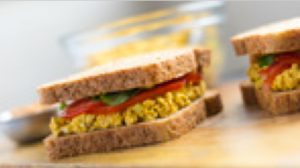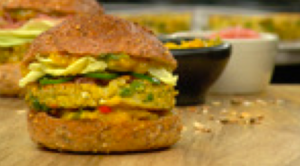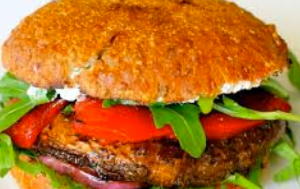Lesson 2: Module 4 Overview
Module 4: Let’s Eat!, is the final Module in the course and follows:
- Module 1: All About Heart Disease – How Diet and Cholesterol are Connected
- Module 2: Looking Toward a Healthy Future – Cognitive Dissonance and Change Challenges
- Module 3: Recognizing Evidence-Based Health Information
The terminal objective for Module 4 is: In real-world settings such as the grocery store, home kitchen and restaurant, the learner will select and prepare foods that support and improve cardiovascular health. The sample activities below are from in Lesson 2 and support the second enabling objective: While shopping for recipe items in a grocery store, the learner will select the most healthful whole foods and simply processed foods for their chosen recipe.
In Lesson 1, students will have viewed a slide presentation and lecture detailing a whole foods, plant-based diet. They will have watched a documentary showing two families learning about how to implement the diet in their lives including cleaning out their kitchen of unhealthy foods, shopping and cooking new recipes and old favorites in a new way. Lesson 2 allows them to deepen their understanding of whole, plant-based foods and how to identify best choices in the grocery store.
This blended learning lesson will occur in a classroom kitchen with instructor led presentations, web-based media and a face-to-face lab session in the grocery store.
Universal Design for Learning
The Universal Design for Learning guiding principles are applied in this set of activities in the following ways:
- Provide Multiple Means of Representation
- Students are given opportunities to integrate key ideas and engage in authentic practice of new skills and knowledge.
- New ideas about heart healthy foods are integrated with familiar ideas and contexts.
- The lesson is designed with graduated access to material. Students absorb material and apply content to support their personal goals and practice new skills.
- Information is presented, demonstrated, and students apply new skills and knowledge in their own lives.
- Key concepts are revisited and the content builds from previous learning.
- Information provided in texts and live presentations are reinforced in a variety of media including illustrations and video.
- Web-based graphic quizzes and review activities will have call-out boxes for background information. Audio/visual digital interfaces are customizable.
- Diet recommendations are taught through different modalities where students work with graphics (seeing), lecture/video clips (hearing) and touch (the shopping activity).
- Key concepts are taught through many means of representation. Students can access the content via lecture/discussion, text, video or graphics.
- Provide Multiple Means of Action and Expression
- There are multiple means to access the information including quizzes with image selection and authentic activities like selecting foods in a store.
- Web-based assessment activities are designed to provide feedback so students can monitor their own learning.
- Feedback will be provided after the shopping activity.
- Provide Multiple Means of Engagement
- Authenticity is provided in real-world context of shopping in a grocery store and implementing behaviors that will support their personal health goals.
- Students are encouraged to reach for ‘progress not perfection’ as they integrate new information. Students choose how to renovate/refresh their current eating habits. For example, there is no one ‘right’ answer on the shopping excursion – only ‘better’ choices can be made.
Module 4: Let’s Eat!
Lesson 2: Making Healthy Choices at Home and at the Grocery Store
In this lesson you will learn to find the best foods that will help you reach your health goals. You will learn about how to identify whole, plant-based foods and how to make the best choice when shopping for prepared and packaged foods in the store. You’ll get a chance to pick a new lunch recipe and go on a scavenge hunt to find all your ingredients. That’s right, you’ll be going shopping!
In this series of activities you will:
- Learn how to maximize best choices while shopping in the grocery store
- Distinguish whole foods and processed foods
- Distinguish simple and hyper processed foods
- Distinguish calorie dense and nutrient dense foods
- Read product labels to determine the best choice available of processed foods
- Apply label reading skills on a trip to the grocery store
ABSORB ACTIVITY #1
(The activities in Lesson 2 follow William Horton’s ‘absorb-do-connect’ framework for organizing instruction. (Horton, 2012) The content of Lesson 2 is presented in two absorb activities. Absorb Activity #1 teaches the concepts of whole and processed foods, nutrient dense versus calorie dense foods, and how to navigate the grocery store to find the best food possible. Students view video clips and can choose to review web-based extended resources.)
How do you make healthy choices at the supermarket? Shopping in a grocery store can be overwhelming! Here’s some tips to consider.
1. Stay on the perimeter of the store for most of your shopping. Watch this:
2. Be informed about simple processed food vs. hyper-processed food. Watch this:
3. Learn about calorie density and just ‘Cut the C. R. A. P.’!
- Make use of these extended resources for fun and inspiration:
DO ACTIVITY #2
(This ‘do’ activity is a chance for students to practice using the information in a web-based activity. There will be check boxes next to images of the listed food items. This is a graded assessment and students will receive feedback for any wrong answers. Students will be able to re-do the activity until they receive 100%.)
Whole foods or processed? Which of the images below show a whole foods approach to cooking and eating? Whole foods are never refined or commercially processed.
Image Select: Click the box below the image to select the whole food. Feel free to repeat this activity until you reach your goal.
- Quinoa Salad
- Fresh Vegetables
- Commercial Pasta
- Olive Oil

- Beans
- White Bread
- Meat Alternatives
- Cabbage
- Radishes
- Roasted Vegetables

ABSORB ACTIVITY #3
(In this ‘absorb’ activity students are shown how to interpret food labels on processed foods and are given guidelines for selecting the best choice possible. Content is presented through an instructor-led slide presentation, articles, info-graphics, and a video clip.)
Understanding Food Labels. Food labels are deliberately deceiving, and it takes a bit of practice to determine what is in the product your are buying! Learn make the best choices when you purchase processed foods.
Even though you will strive to make your food consumption primarily composed of whole and fresh food, you’ll need to buy something in a package at some point. Stick to minimally processed choices that follow these guidelines:
- Less than 20% of calories from fat
- no trans fat
- no cholesterol
- no added oil
- no added sugar
- 2-3 grams per serving of fiber
- less sodium than the number of calories per serving
- intact (whole) grains
- Here are some extra tips for reading food labels:
-
- Know your ingredients. Know where your ingredients come from and try to avoid artificial preservatives, colorings and additives.
- Note the order of ingredients.Make sure the most nutrient-dense ingredient is first on the list. The first ingredient is always the most predominant in the product.
Watch the clip on understanding food labels:
Here’s more resources to explore:
- Read the article by Jeff Novick on making sense of food labels.
- Review the Quick Tip Guide for a Healthy Heart
- Explore this resource and download the infographic guide sheet: how to read a food label the right way.
DO ACTIVITY #4
(This ‘do’ activity is a chance for students to practice using the information in a web-based activity. This is a graded assessment and students will receive feedback for any wrong answers. Students will be able to re-do the activity until they receive 100%. There will be side-by-side Nutrition Facts and Ingredients Lists images for the Simple Processed Foods listed below.)
Let’s practice reading labels before we go shopping! In activity #5 you will select a lunch recipe to shop for and cook in your own kitchen. You might need to buy a packaged food for your recipe.
Compare the following processed food nutrition facts labels on the similar items and select the healthiest choice. (Be sure to note ingredients list on each item.)
Image Select: Nutrition Labels Comparison. Click the box below the best product choice in each category. When you’re done check your answers. Feel free to repeat this activity until you reach your goal.
1. Pasta Sauce Product 1 / Pasta Sauce Product 2
2. Hummus Product 1 / Hummus Product 2
3. Pizza Crust Product 1 / Pizza Crust Product 2
4. Ketchup Product 1 / Ketchup Product 2
5. Burger Buns Product 1 / Burger Buns Product 2
CONNECT ACTIVITY #5
(This ‘connect’ activity is all about applying the information in a real life context.)
Supermarket Scavenge Hunt Activity. Shop for your chosen lunch recipe ingredients in the grocery store!
Lunch Recipe Choices – Select one of the recipes to shop for and prepare at home. Click on the link to reveal the recipe.
- Egg-less ‘Egg’ Salad Sandwich
- Indian Samosa Burger
- Portobello Mushroom Burgers
Stay in the perimeter of the store for most of your ingredients. If you need to buy a processed food such as canned tomatoes, pasta, or burger buns, read the labels and pick the best choice. We’ll review your items before we start cooking in Lesson 3.
Horton, W. (2012) E-Learning by Design. (2nd ed.) San Francisco, CA: Pfeiffer.
Next – Assessment
Instructional Design Portfolio Home









